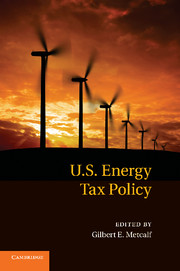Book contents
- Frontmatter
- Contents
- Conference Participants
- 1 Introduction
- 2 Distributional Impacts of Carbon Pricing Policies in the Electricity Sector
- 3 Distributional Impacts of a U.S. Greenhouse Gas Policy
- 4 Instrument Choice Is Instrument Design
- 5 Taxes, Permits, and Climate Change
- 6 Border Adjustments for Carbon Taxes and the Cost of Emissions Permits
- 7 Taxes and Caps as Climate Policy Instruments with Domestic and Imported Fuels
- 8 How Much Should Highway Fuels Be Taxed?
- 9 State Tax Policy and Oil Production
- 10 The Social Costs and Benefits of U.S. Biofuel Policies with Preexisting Distortions
- Index
- References
8 - How Much Should Highway Fuels Be Taxed?
Published online by Cambridge University Press: 01 June 2011
- Frontmatter
- Contents
- Conference Participants
- 1 Introduction
- 2 Distributional Impacts of Carbon Pricing Policies in the Electricity Sector
- 3 Distributional Impacts of a U.S. Greenhouse Gas Policy
- 4 Instrument Choice Is Instrument Design
- 5 Taxes, Permits, and Climate Change
- 6 Border Adjustments for Carbon Taxes and the Cost of Emissions Permits
- 7 Taxes and Caps as Climate Policy Instruments with Domestic and Imported Fuels
- 8 How Much Should Highway Fuels Be Taxed?
- 9 State Tax Policy and Oil Production
- 10 The Social Costs and Benefits of U.S. Biofuel Policies with Preexisting Distortions
- Index
- References
Summary
Introduction
The United States imposes, at the federal and state levels, excise taxes of about 40 cents/gallon on gasoline and 45 cents/gallon on diesel for heavy trucks. The federal tax on these fuels is currently 18.4 and 24.4 cents/gallon, respectively (FHWA 2007, Tables 8.2.1 and 8.2.3). The U.S. tax rates are low by international standards; for example, in many European countries gasoline taxes exceed $2/gallon, although the United States is somewhat unusual in taxing diesel more heavily than gasoline, albeit only slightly (Figure 8.1).
Traditionally, the level of fuel taxes in the United States has been governed by highway spending needs; fuel tax revenues account for about two-thirds of the approximately $100 billion in revenues raised from all highway user fees. However, there is growing debate about both the appropriate level of federal fuel taxes and their status as a dedicated revenue source.
One reason is the weakening link between fuel taxes and highway spending. A rising portion of this spending has been financed through nonhighway revenues (e.g., local sales and property taxes), and some fuel tax revenues have been diverted for other purposes (e.g., transit projects). Moreover, there is concern about the erosion of real fuel tax revenues per vehicle mile, especially with the recent tightening of fuel economy regulations, and the failure of nominal tax rates to rise with inflation (federal gasoline and diesel taxes were last increased in 1993).
- Type
- Chapter
- Information
- US Energy Tax Policy , pp. 269 - 296Publisher: Cambridge University PressPrint publication year: 2010
References
- 3
- Cited by



